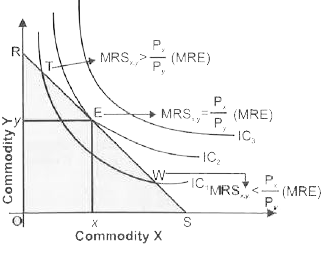Text Solution
Verified by Experts
|
Topper's Solved these Questions
CONSUMER EQUILIBRIUM
FULL MARKS|Exercise MORE QUESTIONS SOLVED (VI. HIGHER ORDER THINKING SKILLS (HOTS))|9 VideosView PlaylistCONSUMER EQUILIBRIUM
FULL MARKS|Exercise MORE QUESTIONS SOLVED (VII. VALUE BASED QUESTIONS)|1 VideosView PlaylistCONSUMER EQUILIBRIUM
FULL MARKS|Exercise MORE QUESTIONS SOLVED (IV. TRUE OR FALSE) (Giving reasons, state whether the following statements are true or false. )|12 VideosView PlaylistCOST
FULL MARKS|Exercise NCERT TEXTBOOK QUESTIONS SOLVED|137 VideosView Playlist
Similar Questions
Explore conceptually related problems
Knowledge Check
A
B
C
D
Submit
A
B
C
D
Submit
Similar Questions
Explore conceptually related problems
FULL MARKS-CONSUMER EQUILIBRIUM -MORE QUESTIONS SOLVED (V. LONG ANSWER TYPE QUESTIONS )
- Explain consumer's equilibrium in case of a single commodity with the ...
Text Solution
|
Play - State condition of consumer equilibrium in case of a single commodity ...
Text Solution
|
Play - There is given the market price of a piece of goods , how does a consu...
Text Solution
|
Play - How many units of a commodity should a consumer buy to get its maximum...
Text Solution
|
Play - There is given the price of a good , how does a consumer decide as to ...
Text Solution
|
Play - A consumer consumes only two goods. Explain the Conditions of the cons...
Text Solution
|
Play - State and explain the condition of consumer equilibrium in case of two...
Text Solution
|
Play - For a consumer to be in equilibrium why must marginal rate of substitu...
Text Solution
|
Play - Using indifference curve approach , explain the conditions of consumer...
Text Solution
|
Play - Why is the consumer in equilibrium when he buys only that combination ...
Text Solution
|
Play - What are the conditions of consumer's equilibrium under the indifferen...
Text Solution
|
Play - State and explain the conditions of consumer's equilibrium in indiffer...
Text Solution
|
Playing Now - Explain consumer equilibrium using the concept of budget line and indi...
Text Solution
|
Play - A consumer consumes only two of goods . For the consumes to be in only...
Text Solution
|
Play - A consumer consumes only two goods. Explain the conditions that need t...
Text Solution
|
Play - Show diagrammatically the conditions for consumer's equilibrium in Hic...
Text Solution
|
Play - Differentiate between Cardinal and Ordinal Utility .
Text Solution
|
Play
